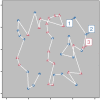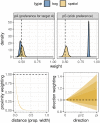Foraging as sampling without replacement: A Bayesian statistical model for estimating biases in target selection
- PMID: 35073315
- PMCID: PMC8812991
- DOI: 10.1371/journal.pcbi.1009813
Foraging as sampling without replacement: A Bayesian statistical model for estimating biases in target selection
Erratum in
-
Correction: Foraging as sampling without replacement: A Bayesian statistical model for estimating biases in target selection.PLoS Comput Biol. 2023 Mar 17;19(3):e1010997. doi: 10.1371/journal.pcbi.1010997. eCollection 2023 Mar. PLoS Comput Biol. 2023. PMID: 36930605 Free PMC article.
Abstract
Foraging entails finding multiple targets sequentially. In humans and other animals, a key observation has been a tendency to forage in 'runs' of the same target type. This tendency is context-sensitive, and in humans, it is strongest when the targets are difficult to distinguish from the distractors. Many important questions have yet to be addressed about this and other tendencies in human foraging, and a key limitation is a lack of precise measures of foraging behaviour. The standard measures tend to be run statistics, such as the maximum run length and the number of runs. But these measures are not only interdependent, they are also constrained by the number and distribution of targets, making it difficult to make inferences about the effects of these aspects of the environment on foraging. Moreover, run statistics are underspecified about the underlying cognitive processes determining foraging behaviour. We present an alternative approach: modelling foraging as a procedure of generative sampling without replacement, implemented in a Bayesian multilevel model. This allows us to break behaviour down into a number of biases that influence target selection, such as the proximity of targets and a bias for selecting targets in runs, in a way that is not dependent on the number of targets present. Our method thereby facilitates direct comparison of specific foraging tendencies between search environments that differ in theoretically important dimensions. We demonstrate the use of our model with simulation examples and re-analysis of existing data. We believe our model will provide deeper insights into visual foraging and provide a foundation for further modelling work in this area.
Conflict of interest statement
The authors have declared that no competing interests exist.
Figures









References
-
- Pyke GH. Optimal foraging theory: a critical review. Annual review of ecology and systematics. 1984;15(1):523–575. doi: 10.1146/annurev.es.15.110184.002515 - DOI
-
- Brown JS. Patch use as an indicator of habitat preference, predation risk, and competition. Behavioral ecology and sociobiology. 1988;22(1):37–47. doi: 10.1007/BF00395696 - DOI
Publication types
MeSH terms
LinkOut - more resources
Full Text Sources

